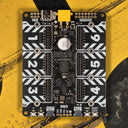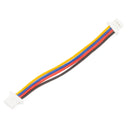Pimoroni Yukon
by Pimoroni











A high-power modular robotics and engineering platform, built around RP2040 and designed to drive the most ambitious robots, props and devices.
The Do-Everything Board 🦾
Yukon is a standalone controller that can be equipped with up to six interchangeable modules capable of driving high-powered hardware - this is made possible by the unique pin capabilities of Raspberry Pi's multitalented RP2040 chip. This flexibility means you can drive many unique combinations of motors, servos, steppers, speakers, LED strips and more, all from a single Yukon host!*
To ensure Yukon creations are adventure proof, each module is screwed down to ensure a solid mechanical and electrical connection.
Assembling Yukon 🚧
Big electronic projects can often involve a lot of soldering, splicing and other complicated assembly techniques, but not with Yukon! The host board and modules use solderless connectors wherever possible so it's fast and friction-free to get started, and simple to swap out components if you need to.
Powering Yukon ⚡
Supplying external power to Yukon is easy thanks to its chunky XT30 connector, which enables you to attach 2 to 4 cell Lithium Polymer (LiPo) batteries (or any other source from 5V to 17V) to deliver up to 15A continuous for your high-power projects.
An e-Fuse with switchable output is included to protect from accidental overvoltage and overcurrent events, along with internal sensors for monitoring voltage, current, and temperature whilst your programs run.
Programming Yukon 💾
Yukon is supported by a comprehensive MicroPython library with a whopping 50 (!) examples showing how to use the individual features of the board and all of its modules. There are also fully fledged showcase examples to show you how Yukon can be used to build a remote-controlled rover, spider tank, and pen plotter.
Features
- Powered by RP2040 (Dual Arm Cortex M0+ running at up to 133MHz with 264kB of SRAM)
- 16MB of QSPI flash supporting XiP
- 6 x slots for high power modules
- E-Fuse with switchable output (40A overcurrent and 18V overvoltage protection)
- XT30 connector for V+ and logic power (5 to 17V, 15A continuous)
- USB-C for programming and logic power
- Power on-off button
- 3 x user buttons (one of which also acts as BOOTSEL for entering DFU mode)
- 2 x power and 2 x user LEDs
- 2 x Qw/ST connectors for attaching breakouts
- Internal voltage in, voltage out, current, and temperature sensors
- Unpopulated header for attaching Breakout Garden boards
- Unpopulated expansion headers for wiring up external buttons and extra IO
- Fully assembled
- No soldering required (unless you want to use the Breakout Garden or expansion headers).
- M2 screws for attaching modules
- Rubber feet 🐾
- MicroPython firmware and library
-
Yukon modules and other components are sold separately.
Yukon Make Anything! Kit Includes
You can buy a Yukon host (plus screws and feet) on its own, or as part of the fully-featured Yukon Make Anything! Kit, which sets you up with all the tools to make a bunch of cool stuff. It includes six different modules for driving a diverse range of hardware, plus a selection of useful cables for feeding your Yukon power and data.
- Yukon Host (plus screws and feet)
- Dual Motor / Bipolar Stepper Module
- Quad Servo [Regulated] Module
- LED Strip Module
- Audio Amp Module
- Dual Switched Power Output Module
- Proto Module
- USB-A to USB-C cable for programming
- Loose wire to XT30 cable for power
- XT60 to XT30 cable for power
- ...all packed up neatly in a reusable Pirate-brand Loot Box.
Yukon Modules
Customise Yukon to suit almost any project with our range of addon modules. You can populate your Yukon with a full load-out right away, or start with a few modules and expand as your project grows. There's also a proto module, for if you want to add a custom module like a buzzer or a potentiometer.
Motors |
Servos |
Output |
Audio |
Lighting |
Communication |
Prototyping |
|
Pinout and Schematic
Getting Started
You can find Yukon documentation, code examples and MicroPython builds at the link below:
If you'd like to program Yukon from an Android phone then you could try the DroidScript app, available on Google Play. You'll need a USB-C cable and a recent version of MicroPython firmware installed on the board.
Connecting Breakouts
The Qw/ST connectors on Yukon make it super easy to connect up Qwiic or STEMMA QT breakouts. If your breakout has a QW/ST connector on board, you can plug it straight in with a JST-SH to JST-SH cable.
Breakout Garden breakouts that don't have a Qw/ST connector can be connected using a JST-SH to JST-SH cable plus a Qw/ST to Breakout Garden adaptor. Want to use multiple Qw/ST breakouts at the same time? Try this adaptor!
- List of breakouts currently compatible with our MicroPython build.
Notes
- Measurements: 84mm x 67mm x 14mm (L x W x H). The mounting holes are M2.5 and 3mm in from each edge.
- Yukon has some extra broken out headers that adventurous makers might find useful (note that these are unpopulated and so will require soldering):
- Control header for connecting up external on-off and user/boot buttons, as well as an external power LED
- Expansion header for connecting up external A and B user buttons, an LCD display (or use as GPIO), and SWD debugging
- The board's current draw when off is 2.05mA @ 5V and 3.25mA @ 17V. As such it is recommended to disconnect any battery pack if the project is not going to be used for a while, to avoid unnecessary draining.
- Yukon comes with kapton tape on top of its 8 mounting posts. Remove these before installing any modules.
- * Some slot placement and combinations of modules may not be compatible due to shared pin functions
About RP2040
Raspberry Pi's RP2040 microcontroller is a dual core ARM Cortex M0+ running at up to 133Mhz. It bundles in 264kB of SRAM, 30 multifunction GPIO pins (including a four channel 12-bit ADC), a heap of standard peripherals (I2C, SPI, UART, PWM, clocks, etc), and USB support.
One very exciting feature of RP2040 is the programmable IOs which allow you to execute custom programs that can manipulate GPIO pins and transfer data between peripherals - they can offload tasks that require high data transfer rates or precise timing that traditionally would have required a lot of heavy lifting from the CPU.
-
Yukon Host Only
PIM687£20.00 -
Yukon Starter Kit
PIM688Out of stock£75.00
Yukon cables and connectors
Yukon feed data and power to your board with these!
-
 USB-A to USB-C Cable+ £3.25
USB-A to USB-C Cable+ £3.25 -
 XT30 Adapter Cables+ £2.50
XT30 Adapter Cables+ £2.50 -
 Amass XT30 Connector+ £0.75
Amass XT30 Connector+ £0.75 -
 Dual Silicone Wire (per metre)+ £1.50
Dual Silicone Wire (per metre)+ £1.50 -
 4 Pin JST-SH Cable (Qwiic, STEMMA QT, Qw/ST)+ £1.25
4 Pin JST-SH Cable (Qwiic, STEMMA QT, Qw/ST)+ £1.25
Yukon batteries and accessories
Yukon use these to take your project on the go!
-
 Supersport Pro LiPo Battery (XT60 Connector)+ £17.50
Supersport Pro LiPo Battery (XT60 Connector)+ £17.50
Shop with confidence – we've been serving the hobbyist electronics, Maker, and retro gaming communities since 2012.
- Satisfaction or refund guarantee
- Worldwide shipping via mail or courier
- 57,000+ customer reviews
- Secure website and payments









